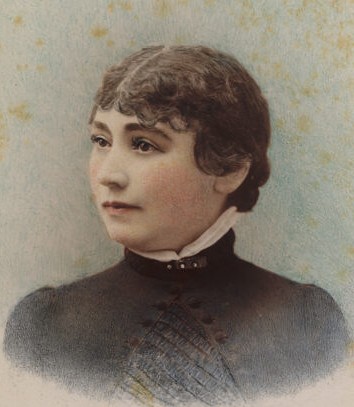The Scariest Part of the Winchester Mansion Has Nothing to Do with Ghosts
Credit to Author: Becky Ferreira| Date: Tue, 31 Oct 2017 16:30:00 +0000
The Winchester Mystery House, a labyrinthine Victorian mansion in San Jose, California, has been one of America’s creepiest homes since ground broke on its construction. Conceived by the secretive heiress Sarah Winchester and built over decades without a master blueprint, the home contains hidden passages, spy holes, crooked hallways, doors that lead nowhere, and roughly 160 rooms, including an attic hideout that was only discovered by house staff last year.
Now, this architectural freak-show is getting its own movie: Winchester: The House That Ghosts Built, set for release in February 2018. Starring Helen Mirren as Sarah Winchester, the film will be a rollercoaster of jump scares, judging from the newly released trailer.
The preview promises a barrage of spirits, souls, demons, ghosts, entities, apparitions, shadows, beings, devils, poltergeists, wraiths, and spectres, in that order. But it’s not clear to what extent the film will grapple with the scariest part of the Winchester Mystery House legacy: the blood money that funded it.
Sarah Winchester was the widow of William Wirt Winchester, who served as treasurer of the Winchester Repeating Arms Company until his death in 1881. This firearms manufacturer was among the first enterprises to mass-produce rifles with the capacity to fire multiple rounds between reloads. The popular Winchester Model 1873 rifle gained a reputation as the “gun that won the West” because it was frequently used by foreign settlers and Native Americans during the American Indian wars.
With over 720,000 rifles produced between 1873 and 1916, the sheer ubiquity of Winchester rifles had a profound impact on American history. Not only did this family company help to foster the zealous gun culture endemic to the United States, it resulted in untold numbers of deaths.
This human toll weighed heavily on Sarah Winchester, or so the story goes. After her husband died, she inherited his $20 million estate (worth nearly half a billion dollars today, adjusting for inflation). She used this vast fortune to commission the infamous mansion that bears her dynasty’s name.
Legends have circulated that Winchester felt haunted by victims of the weapon that shared her name and ensured her prosperity. Her home, with its disorienting passageways and walled-off rooms, was said to have been purposely designed to outwit and escape these restless spirits.
One popular claim is that Winchester’s constant additions to the house, from 1886 to her death in 1922, were motivated by “a message from the spirit world warning her that all would be well so long as the sound of hammers did not cease in the house or on the grounds,” according to a June 1911 article in The New York Times.
Because Winchester was reclusive and eccentric, these tales about her abounded during her lifetime, and especially in the wake of her death of heart failure at age 83. But their veracity is contested by historians. For instance, Mary Jo Ignoffo, author of the 2010 biography Captive of the Labyrinth, suggests that news outlets scapegoated the wealthy widow to relieve collective American guilt about the proliferation of deadly firearms.
“Toward the end of the 19th century, the American press began to seriously acknowledge the brutality used against American Indians, and the American conscience began to be bothered by Indian atrocities,” Ignoffo points out in the book. “Sarah Winchester’s reputation suffered scathing attacks of insult and ridicule beginning at the same time […] Newspapers pinned the burden of guilt for Winchester-induced deaths on the widow but there is no evidence that Sarah herself felt guilty about the repeating rifle or earning money from it.”
As with any “haunted” location, the reality is that the ghoulish legends surrounding the Winchester Mystery House are mostly exaggerations or outright fabrications.
But in some ways, the story of a rifle heiress placed in the crosshairs by a nation eager to exorcise its culpability over gun deaths is a whole lot creepier than any boilerplate haunted house. It strikes unsettlingly close to home at our current moment, a few weeks after the deadliest mass shooting in modern American history.
The American relationship to guns, and the firearms industry, is unique, complicated, and notorious around the world. Americans are 10 times more likely to be killed by guns compared to citizens of other developed nations, yet firearms regulation remains a polarized issue due to the profound role of guns in the national consciousness.

The Winchester mansion is not only a crucial part of this history, it is a perfect metaphor for the nation’s singular obsession with guns. Sarah Winchester’s compulsion to randomly build new wings and floors with no master plan mirrors America’s half-hearted bandaids on gun policy, which have never amounted to a cohesive vision. Like the doors and passageways within the mystery house, attempts to reduce gun violence in the United States often lead nowhere, or circle back on themselves.
And, true or not, if part of Sarah Winchester’s legend is that she believed hammering would keep the spirits of gun victims at bay, then the phrase “now is not the time to talk about gun violence” is the modern incarnation of those construction sounds.
While one shouldn’t judge a movie from its trailer, it looks like Mirren’s Winchester will focus on the sensational legends associated with the controversial widow. But in the wake of smart horror commentaries like Get Out, it would be refreshing to see the film integrate ghostly thrills with the Sisyphean saga of gun violence in America—because few things are scarier than that.
Get six of our favorite Motherboard stories every day by signing up for our newsletter.